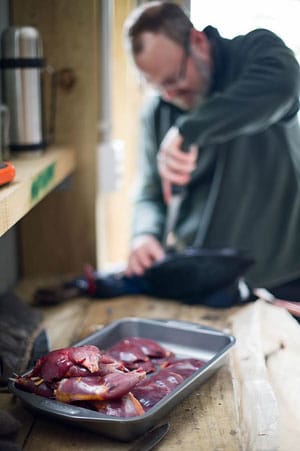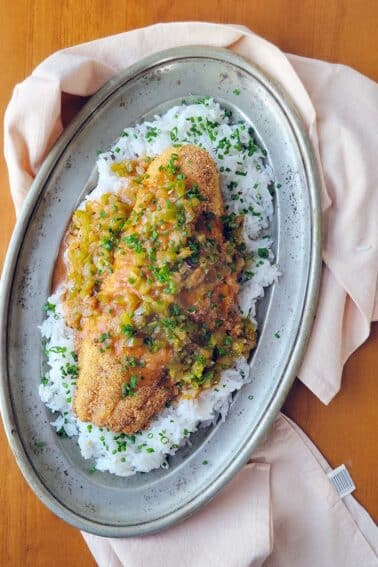As an Amazon Associate I earn from qualifying purchases.

Every culture has its unloved fish or game, an animal that, for mysterious reasons, gets little respect either as quarry or table fare. In New Zealand, it is a curious bird called the pukeko.
Porphyrio porphyrio melanotus is the subspecies of this bird that lives in New Zealand, but the purple swamp hen has an enormous range, from the Pacific Islands to Australia, India, Africa, parts of the Mediterranean world, and even, recently, in southern Florida, where they’ve escaped captivity and are now having a lovely time in the swamps there. They are a rail, and are closely related to the purple gallinule, Porphyrio martinicus, of our own Deep South.
Any North American hunter will notice how much these birds resemble our common coots. Coots are generally unloved here in America (outside of Louisiana), and New Zealanders tell the same joke about cooking them with a shoe for days, then tossing the coot or pukeko out and eating the shoe that Americans do with coots.
But the jokesters are wrong. Dead wrong.
I do eat coots — I have two recipes for them in my cookbook Duck, Duck, Goose: Recipes and Techniques for Cooking Waterfowl, Both Farmed and Wild — but that’s another post. Pukekos are larger, about the size of a small chicken, harder to kill, smarter, and, most of all, tastier. And after eating plenty of them during our trip, I cannot for the life of me figure out why New Zealanders seem to look down on this bird so much.

Holly and I hunted pukeko several times during our trip the South Island, and, frankly, now that I have I’d much rather hunt them than mallards. Mallards I can hunt anywhere. Hunting pukekos gives me the same rush as hunting snipe. It’s upland game bird hunting: walk, flush, shoot, repeat, only at the edges of wet places. Wellies instead of hiking boots. Pukeko are clever, behaving a lot like those teeny velociraptors that eat the guy in Jurassic Park. They fly a lot faster than you think and take a hit better than most pheasants.
And then there are those claws and beak. They have a beak like a moa, a brute force, multi-purpose Leatherman of an appendage. And, well, their claws would make a velociraptor proud. If you think a coot’s claws are not to be trifled with — and they’re not — these are far nastier. Make sure the bird is dead before you pick him up.
Once you get yourself a passel of pukeko, you need to clean them. Since they kinda-sorta look like blue pheasants, which is another name for them in New Zealand, I tried plucking them like one. No dice. Pukeko show they are closer to a coot or rail or snipe when you notice they have black down feathers underneath that pretty purple. Dry plucking one the morning after the hunt was a non-starter. One of our hosts, Barry Cleghorn, has a mechanized plucker he uses for mallards, and that worked fine. Plucking a pukeko like a snipe or duck, with hot water and melted wax, would be the way to go.
Most of the pukeko we got we skinned. They skin easily, revealing lots of orangey-yellow fat. At first we were alarmed. Normally orange fat is a sad thing to see in a bird, because it suggests they had been eating crustaceans, which will tinge an animal’s fat the color of a cooked crab. But these birds weren’t eating shrimpy things. They were eating grass, which is extremely high in beta carotene — and it was the origin of the orangey fat. I can tell you there was no off taste to the meat whatsoever.

I am glad we did get to eat one pukeko with its skin on, however. I cooked the skin-on breasts in butter with just salt and pepper for Jendy Harper, a New Zealand TV reporter who came out to do a story on the odd Americans eating pukekos, and it was spectacular. I’d already served pukeko breasts (skin off) for some previous hosts, cooked the same way but with my South Carolina BBQ sauce, and everyone — even the New Zealand pukeko haters — loved it. Pukeko breast cooked like a steak tastes miraculously like venison backstrap. I am not making this up. It really does. After eating some, Jendy slipped up twice, calling the meat “venison.” And the skin was an extra crispy bit on top of that lovely venison flavor.
Pukeko breasts are small for the bird’s size, as are those of coots — or like old school chickens, before the “double breasted” chicken became the industry standard. The real prize are the legs. But therein lies the root of the disdain New Zealanders have with pukeko. You will always hear something along the lines of oh, they’re too stringy or the legs are inedible. The Kiwis aren’t crazy, but nor are they thinking the problem through.

The drumsticks of both coots and pukekos — hell, any bird that walks around for a living — will necessarily be heavy with sinew. Sure, there is fine meat to be had between those sinews, but that requires you to slow cook them in a stew or braise, then to fish them out and strip the meat away from the sinew, as I do with my pheasant leg pozole. But the drumstick isn’t the whole leg. People are forgetting the thigh.
Pukeko thighs are basically the same size as pheasant thighs, which is to say they are the size of a small chicken thigh. There is no sinew and only the one bone running through it. And I’d rather eat the thighs of chicken, turkey, pheasant — or pukeko — than any other part. Incidentally, Pukeko thighs are lighter in color than their breast meat, and will actually cook up like dark-meat pheasant or wild turkey.
I made Spanish chilidron with pukeko thighs for Jendy and her husband Andrew Currie, who works for New Zealand’s Fish & Game Department, and Andrew filmed it. So if you’ve always wanted to make my chilindron recipe but wanted a tutorial, watch the video.
Bottom line: Give pukeko a chance. And since they are so closely related to our own purple gallinules, which I have not yet hunted or eaten, that gives me a new goal next time I am down South. I bet they taste the same. I am looking forward to finding out!




Thanks for posting that Hank. I am about to cull some problem pukekos and I was wondering about keeping some meat. After reading your article I now intend to try it. Best wishes from Nelson, New Zealand
I enjoy eating the old pukeko and have fond memories of it from my grandmother as she used to either do a casserole or soup and they were common prey for my grandfather and even was the first game bird I learnt to hunt and even took my son out for the first time this year and bagged a couple for dinner
The story goes:
Throw them in a pot of boiling water with a large stone.
Boil them for three days.
Throw the pukeko way and eat the stone.
Hi,
I assume you cook it like duck – medium…. or do you have to treat it like chicken.
Cheers
Roland: Exactly. Cook it like duck. Breasts medium, legs and thighs slow and low.
60 years ago in North Otago Pukeko were so thick in numbers grain paddocks near waterways looked like a roller had gone through them and they used to have a drive to try and keep them out of the grain. I remember having a meal of baked pukeko and it was very nice and pukeko soup is the best and tastiest soup of all, really really nice.
They really are an underrated game bird. So if you shoot one don’t waste it.
Cheers everyone
Their blue feathers are very important for some popular New Zealand trout flies such as Craigs Nightime, Taihape Tickler and Black Phantom.
Hank,
I too marveled at the under appreciated pukeko when I was a NZ exchange guest last year. If only we had such a great native wet grassland galinule here in California’s northcoast. And yes, they are probably awaiting the cooking exploration to bring out their deserved gamebird respect.
Mitch
Hi, Great to hear you had a trip down to New Zealand. We eat the pukeko we shoot. Our favorite way to eat the breast is to cut them thinly and tenderise them, then flour, egg and breadcrumb them like schnitzel. Nice. Looking forward to trying your suggestions.
Florida has established populations of Purple Swamphen, though I do not know the hunting regulations.
I shoot a few of these with my bow. With regards to the Maori question, the maoris these days pack themselves into cities and eat crap from Mcdonalds. If they do cook them it’s in the ground with a pile of hot rocks.(Hangi)
I guess my question regarding those gnarly drumsticks would be… do they confit?
Chanman: I don’t see why not, but you’d still need to strip the meat off the sinews.
Jack: I am sure some do, but even a Maori chef in New Zealand wrote in his cookbook that he never did.
Do the Maoris eat pukeko and, if so, how do they cook them?